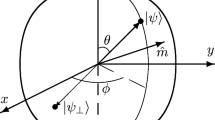Abstract
Using random matrix techniques and the theory of Matrix Product States we show that reduced density matrices of quantum spin chains have generically maximum entropy.
Similar content being viewed by others
References
Jaynes, E.T.: Information theory and statistical mechanics. Phys. Rev. 106(4), 05 (1957)
Jaynes, E.T.: Information theory and statistical mechanics. ii. Phys. Rev. 108(2), 10 (1957)
Landau, L.D., Lifshitz, E.M.: Course of theoretical physics. Vol. 5: Statistical physics. Translated from the Russian by J. B. Sykes and M. J. Kearsley. Second revised and enlarged edition. Oxford: Pergamon Press, 1968.
Jaynes, E.T.: Where do we stand on maximum entropy? In: Maximum entropy formalism (Conf., Mass. Inst. Tech., Cambridge, Mass., 1978), Cambridge, MA: MIT Press, 1979, pp. 15–118
Popescu S., Short A.J., Winter A.: Entanglement and the foundations of statistical mechanics. Nat. Phys. 2(11), 754–758 (2006)
Vinayak, Žnidarič M.: Subsystem dynamics under random hamiltonian evolution. J. Phy. A: Math. Theor. 45(12), 125204 (2012)
Masanes L., Roncaglia A.J., Acin A.: The complexity of energy eigenstates as a mechanism for equilibration. Phys. Rev. E. 8, 032137 (2013)
Brandão F.G.S.L., Ćwikliński P., Horodecki M., Horodecki P., Korbicz J. K., Mozrzymas M.: Convergence to equilibrium under a random hamiltonian. Phys. Rev. E 86, 031101 (2012)
Cramer M.: Thermalization under randomized local hamiltonians. New J. Phys. 14(5), 053051 (2012)
Linden N., Popescu S., Short A. J., Winter A.: Quantum mechanical evolution towards thermal equilibrium. Phys. Rev. E 79, 061103 (2009)
Linden N., Popescu S., Short A. J., Winter A.: On the speed of fluctuations around thermodynamic equilibrium. New J. Phys. 12(5), 055021 (2010)
Cramer M., Flesch A., McCulloch I.P., Schollwöck U., Eisert J.: Exploring local quantum many-body relaxation by atoms in optical superlattices. Phys. Rev. Lett 101, 063001 (2008)
Flesch A., Cramer M., McCulloch I.P., Schollwöck U., Eisert J.: Probing local relaxation of cold atoms in optical superlattices. Phys. Rev. A 78, 033608 (2008)
Trotzky S., Chen Y.-A., Flesch A., McCulloch I.P., Schollwock U., Eisert J., Bloch I.: Probing the relaxation towards equilibrium in an isolated strongly correlated one-dimensional bose gas. Nat Phys 8(4), 325–330 (2012)
Jaynes E.T.: Prior probabilities. Systems Science and Cybernetics, IEEE Transactions on 4(3), 227–241 (1968)
White Steven R.: Density matrix formulation for quantum renormalization groups. Phys. Rev. Lett. 69, 2863–2866 (1992)
Hastings M.B.: An area law for one-dimensional quantum systems. J. Stat. Mech. Theory Exp. 2007(08), P08024 (2007)
Perez-Garcia D., Verstraete F, Wolf M.M., Cirac J.I.: Matrix product state representations. Quantum Inf Comp. 7(5 & 6), 1–28 (2006)
Collins B., Nechita I.: Random quantum channels i: Graphical calculus and the bell state phenomenon. Commu. Math. Phys. 297(2), 345–370 (2010)
Garnerone, S., de Oliveira, T.R., Zanardi, P.: Typicality in random matrix product states. Phys. Rev. A 81(3), 03 (2010)
Garnerone, S., de Oliveira, T.R., Haas, S., Zanardi, P.: Statistical properties of random matrix product states. Phys. Rev. A 82(5), 11 (2010)
Goldstein S., Lebowitz J., Tumulka R., Zangh‘ıN.: On the distribution of the wave function for systems in thermal equilibrium. J. Stat. Phys. 125, 1193–1221 (2006)
Reimann P.: Typicality for generalized microcanonical ensembles. Phys. Rev. Lett. 99, 160404 (2007)
Goldstein S., Lebowitz J.L., Tumulka R., Zangh‘ıN.: Long-time behavior of macroscopic quantum systems. The Eur. Phys. J. H 35, 173–200 (2010)
Bañuls M.C., Cirac J.I., Hastings M.B.: Strong and weak thermalization of infinite nonintegrable quantum systems. Phys. Rev. Lett. 106, 050405 (2011)
Weingarten D.: Asymptotic behavior of group integrals in the limit of infinite rank. J. Math. Phys. 19, 99–1001 (1978)
Collins B.: Moments and cumulants of polynomial random variables on unitarygroups, the Itzykson-Zuber integral, and free probability. Int. Math. Res. Not. 2003(17), 953–982 (2003)
Fulton, W.: Young tableaux, Volume 35 of London Mathematical Society Student Texts. Cambridge: Cambridge University Press, 1997
Milman, V.D., Schechtman, G.: Asymptotic theory of finite dimensional normed spaces. Lecture Notes in Mathematics. Berlin-Heidelberg-New York: Springer, 1986
Ledoux, M.: The concentration of measure phenomenon, Volume 89 of Mathematical Surveys and Monographs. Amet. Math. Soc., RI: Providence, 2001
Collins B., ’Sniady P.: Integration with respect to the Haar measure on unitary, orthogonal and symplectic group. Commun. Math. Phys. 264, 773–795 (2006)
Montanaro, A.: Weak multiplicativity for random quantum channels. Commun. Math. Phys. 319(2), 535–555 (2013)
Author information
Authors and Affiliations
Corresponding author
Additional information
Communicated by H.-T. Yau
Rights and permissions
About this article
Cite this article
Collins, B., González-Guillén, C.E. & Pérez-García, D. Matrix Product States, Random Matrix Theory and the Principle of Maximum Entropy. Commun. Math. Phys. 320, 663–677 (2013). https://doi.org/10.1007/s00220-013-1718-x
Received:
Accepted:
Published:
Issue Date:
DOI: https://doi.org/10.1007/s00220-013-1718-x




